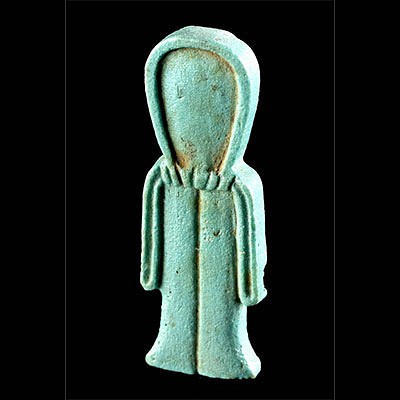Egyptian Pottery Overseer Ushabti for Pa-em-Penedj
Lot 4a
About Seller
Artemis Fine Arts
686 S Taylor Ave, Ste 106
Louisville, CO 80027
United States
Selling antiquities, ancient and ethnographic art online since 1993, Artemis Gallery specializes in Classical Antiquities (Egyptian, Greek, Roman, Near Eastern), Asian, Pre-Columbian, African / Tribal / Oceanographic art. Our extensive inventory includes pottery, stone, metal, wood, glass and textil...Read more
Categories
Estimate:
$1,000 - $1,500
Absentee vs Live bid
Two ways to bid:
- Leave a max absentee bid and the platform will bid on your behalf up to your maximum bid during the live auction.
- Bid live during the auction and your bids will be submitted real-time to the auctioneer.
Bid Increments
| Price | Bid Increment |
|---|---|
| $0 | $25 |
| $300 | $50 |
| $1,000 | $100 |
| $2,000 | $250 |
| $5,000 | $500 |
| $10,000 | $1,000 |
| $20,000 | $2,500 |
| $50,000 | $5,000 |
| $100,000 | $10,000 |
| $200,000 | $20,000 |
About Auction
By Artemis Fine Arts
Nov 4, 2021
Set Reminder
2021-11-04 10:00:00
2021-11-04 10:00:00
America/New_York
Bidsquare
Bidsquare : Ancient & Ethnographic Art Through The Ages
https://www.bidsquare.com/auctions/artemis-gallery/ancient-ethnographic-art-through-the-ages-7799
Ancient art from Egypt, Greece, Italy and the Near East, as well as Asian, Fossils, Pre-Columbian, Native American, African / Tribal / Oceanic, Fine art, and much more! All categories, all price ranges... all legally acquired and guaranteed to be as described or your money back. Artemis Fine Arts info@artemisgallery.com
Ancient art from Egypt, Greece, Italy and the Near East, as well as Asian, Fossils, Pre-Columbian, Native American, African / Tribal / Oceanic, Fine art, and much more! All categories, all price ranges... all legally acquired and guaranteed to be as described or your money back. Artemis Fine Arts info@artemisgallery.com
- Lot Description
Ancient Egypt, Third Intermediate Period, 21st to 22nd Dynasty, ca. 1069 to 720 BCE. A hand-built pottery overseer ushabti of an attractive type, standing in mummiform with legs peeking out from beneath a bulky skirt, all decorated with white, black, and faint yellow pigment. The standing figure presents with the left arm draped at his hip, his right hand holding a black-painted whip crossed atop his chest, and a black tool bag draped behind his right shoulder. The protruding countenance bears almond-shaped eyes with elongated canthi beneath sweeping brows, a black fillet, and a tripartite wig with lappets draped to his clavicle. When translated, an enclosed column of hieroglyphs in front of the legs reads, "The Illuminate, the Osiris, Pa-em-Penedj." Size: 1.375" W x 3.625" H (3.5 cm x 9.2 cm); 4.25" H (10.8 cm) on included custom stand.
Provenance: private New York, New York, USA collection; ex-Julian Bird collection, London, England; ex-John Nicholson Auction, May 22, 2013, lot 1594
All items legal to buy/sell under U.S. Statute covering cultural patrimony Code 2600, CHAPTER 14, and are guaranteed to be as described or your money back.
A Certificate of Authenticity will accompany all winning bids.
PLEASE NOTE: Due to recent increases of shipments being seized by Australian & German customs (even for items with pre-UNESCO provenance), we will no longer ship most antiquities and ancient Chinese art to Australia & Germany. For categories of items that are acceptable to ship to Australia or Germany, please contact us directly or work with your local customs brokerage firm.
Display stands not described as included/custom in the item description are for photography purposes only and will not be included with the item upon shipping.
#167960Figure repaired across waistline as well as repair to small area on right side of feet, with light adhesive residue and earthen material along break lines. Chips to front of feet, back of left arm, and back of head as shown, with light abrasions and encrustations, and fading to areas of pigment. Great preservation to overall form. Hieroglyphs are slightly worn but still mostly legible.Condition
- Shipping Info
-
All shipping is handled in-house for your convenience. Your invoice from Artemis Gallery will include shipping calculation instructions. If in doubt, please inquire BEFORE bidding for estimated shipping costs for individual items.
-
- Buyer's Premium



 EUR
EUR CAD
CAD AUD
AUD GBP
GBP MXN
MXN HKD
HKD CNY
CNY MYR
MYR SEK
SEK SGD
SGD CHF
CHF THB
THB













